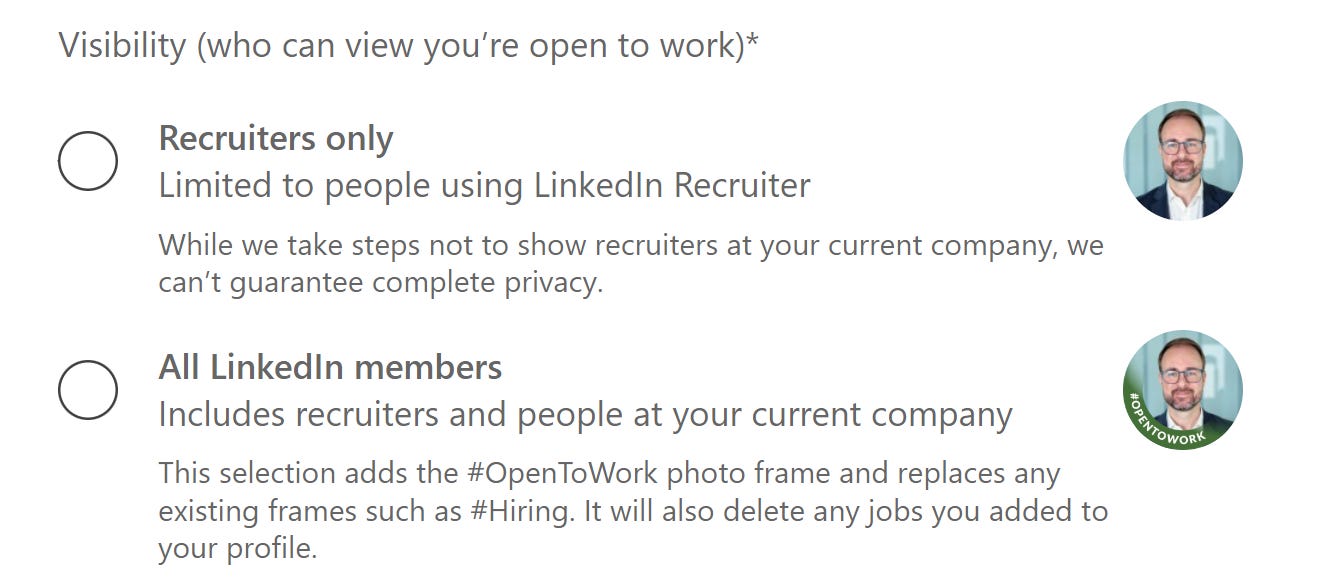How To Job Search While Still Employed
Learn how to job search while employed, protect your privacy, manage recruiters, and handle your manager’s reaction with confidence and professionalism.
Searching for a new job while you’re still employed can feel like walking a tightrope. You want to move forward in your career, but you also need to protect your current position and reputation.
Many people stay in jobs longer than they should simply because they’re afraid of being discovered. They worry their manager might notice changes on LinkedIn, overhear a phone call, or question an unexpected “doctor’s appointment.” And that fear is real, because being caught off guard in the middle of a confidential search can lead to awkward conversations or even lost trust.
But you can absolutely look for a new role while staying professional and discreet. You just need to understand how to control your visibility, manage your time, and set smart boundaries between your current job and your future one.
Let me share with you a step-by-step advice for conducting a job search while employed, from updating your LinkedIn profile quietly to scheduling interviews without raising suspicion.
Why Job Searching While Employed Can Be Smarter
Many people hesitate to look for a new job until they’ve quit their current one. It feels cleaner, less risky, and easier to explain. But in most cases, keeping your current job while exploring new opportunities is actually the smarter move.
Here’s why: When you’re employed, you have stability. You’re not under financial pressure or rushing into the first offer that comes your way. That freedom lets you be selective, take your time, and negotiate better terms. Recruiters and hiring managers also tend to see employed candidates as lower-risk because they’re already active in their field and keeping their skills sharp.
There’s also a mindset advantage. When you’re working, you can evaluate new roles based on real comparisons, not because you are under pressure. You can ask better questions in interviews, like how a team handles deadlines or what their leadership culture feels like, because you already know what’s missing or working in your current role.
Of course, the downside is that you need to balance both worlds carefully. You can’t afford to get distracted, skip meetings, or give your manager reasons to suspect something’s going on. But if you stay organized and thoughtful about your search, this balance becomes your biggest advantage.
The Biggest Risks And How They Show Up
Job searching while employed can work in your favor, but only if you protect your privacy. The moment your manager, colleagues, or HR team notice something unusual, the situation can turn uncomfortable fast.
Here are the most common ways people accidentally reveal their job search:
1. Updating LinkedIn too publicly
You add new skills, change your headline, or turn on “open to work” without realizing your whole network just saw it. Managers often notice these changes, especially in smaller teams. Always review your privacy settings before making any edits.
To prevent showing LinkedIn updates, go to Settings & Privacy from your profile’s “Me” icon, navigate to the Visibility tab, and under Visibility of your LinkedIn activity, turn off the option to ‘Share job changes, education changes, and work anniversaries from profile.
2. Adjust your “Open to Work” settings carefully
LinkedIn lets you show recruiters you’re open without adding the public banner. Choose the “Recruiters only” option so it stays visible only to external recruiters, not your current employer.
Note: Just because you select “only to LinkedIn recruiter” doesn’t mean your current company’s recruiters won’t find out you’re job hunting. Their friends at other companies might see it, and recruiters often share information with each other. So, word can still get around!
3. Using your work computer or email for job-related activity
This is one of the fastest ways to get caught. Company networks, shared drives, or even calendar tools can be monitored. If you apply for jobs or schedule interviews from your work laptop, those traces can show up in IT systems or email logs.
Use a professional email address with your name, but not linked to your work domain. You can set up a separate email just for your job search, or if you’re using Gmail, try adding a dot, like john.doe@gmail.com instead of johndoe@gmail.com. It’s a simple way to keep all your job-related emails organized and separate from your work inbox.
In Gmail, dots in an email address are ignored, so any variation of an address with or without dots goes to the same inbox. For example, johnsmith@gmail.com, john.smith@gmail.com, and j.o.h.n.s.m.i.t.h@gmail.com all lead to the same account.
This feature allows you to use different dotted versions for different subscriptions to help track their origin, as emails sent to a dotted version will still arrive in your main inbox.
4. Scheduling interviews during work hours without cover
Back-to-back “personal appointments” or frequent absences raise suspicion quickly. Even if your manager doesn’t say anything, coworkers notice patterns. If you have a hybrid model, set the online interviews while working from home.
Or try early mornings, lunch breaks, or days off. If you need time during work hours, request a half-day off without overexplaining.
5. Sharing too much with colleagues
Telling even one trusted coworker can backfire. Office gossip spreads easily, and what you meant as a casual comment might reach your manager before you expect it.
Also, keep your references discreet. Use past managers, colleagues, or clients instead of anyone from your current company. If a recruiter asks for current references, say your search is confidential until the offer stage.
These risks don’t mean you shouldn’t search, they just mean you need a clear plan. When you know where mistakes happen, you can build small habits that protect you. Use personal devices, adjust your online presence, and be thoughtful about your schedule.
A careful approach keeps your search invisible until you’re ready to make it public.
Common Myths And Simple Truths
When it comes to searching for a job while still employed, misinformation spreads fast. You’ll hear advice from friends, colleagues, and even career blogs that sounds logical but often leads to mistakes. Let’s clear up some of the most common myths so you can focus on what actually works.
Myth 1: You can’t update your LinkedIn profile without everyone knowing.
Many professionals avoid touching their LinkedIn because they fear it will alert their manager. The truth is, you can update your profile quietly. Turn off “share profile updates,” adjust your visibility settings, and make gradual edits over time. Recruiters will notice your improved profile, but your coworkers won’t see a thing.
Myth 2: It’s disloyal to look for another job while employed.
This belief keeps a lot of people stuck. Searching for new opportunities isn’t betrayal, it’s career management. Companies reorganize, promote, and replace employees all the time. You have every right to explore what’s next, as long as you stay professional and perform well in your current role.
Myth 3: You need to post “Open to Work” publicly to get noticed.
That green banner might feel tempting, but it’s not necessary. Most recruiters use LinkedIn Recruiter, which can see your “open” status even when it’s set to private. Publicly announcing your search adds risk with little reward, especially if your employer or coworkers are active on LinkedIn.
Myth 4: Applying to as many jobs as possible increases your chances.
Quantity doesn’t win this game. Mass applications lead to burnout and poor results. Focus on roles that truly fit your skills and career direction. Tailor your resume and cover letter for each one. You’ll send fewer applications, but each will carry more weight.
Myth 5: You should hide your job search from everyone.
While discretion is smart, isolation isn’t. Trusted contacts, former colleagues, mentors, or recruiters you’ve worked with before, can be valuable allies. You just need to choose carefully. Share your plans privately with people who respect confidentiality and can genuinely help.
Myth 6: You have to quit before you can prepare for interviews.
There’s no rule that says you must leave first. You can prepare after work, schedule interviews outside office hours, and use vacation time for final rounds. This keeps you financially stable while exploring your options. Quitting first only makes sense if your situation has become unbearable or unsafe.
Myth 7: A job search means you’ve given up on your current role.
Not at all. You can still care about your work, your team, and your goals while exploring new opportunities. Think of it as career growth, not rejection. Sometimes searching reminds you of what you actually like about your current role, or what you want to change before making your next move.
When you separate myths from facts, you take back control. The truth is, most professionals will quietly explore new roles at some point in their career. The ones who do it well aren’t reckless, they’re thoughtful, organized, and patient.
And if you approach your job search with that same mindset, you’ll find new doors open more easily than you expected.
Next Steps
Looking for a new job while you’re still employed isn’t easy, but it’s one of the most strategic moves you can make in your career. It gives you freedom, stability, and choice, all without the financial stress that often comes with unemployment. The real challenge isn’t finding opportunities, it’s protecting your privacy and managing your time while you do it.
The next step is simple: keep going, but don’t rush. Treat your job search like a professional project rather than a secret mission. Set small, consistent goals: a few applications per week, one recruiter call every few days, one hour for interview prep on weekends. Consistency protects your focus and helps you make better decisions when offers start coming in.
And when that offer finally arrives, take time to reflect. Does it align with your long-term goals? Does it give you growth, not just escape? A good job move isn’t just about leaving something behind, it’s about stepping toward something better.
If you handle this process thoughtfully, you’ll come out stronger, more confident, and more aware of your value in the market. You’ll also leave your current role with integrity, which is something every professional should aim for.
Remember: a quiet, well-planned job search isn’t about secrecy. It’s about respect, for your current employer, for your future one, and for yourself. When you protect your privacy and act with professionalism, you control your story from start to finish.
Handling the Most Delicate Moments of Your Job Search
You’ve learned how to stay discreet, update your LinkedIn safely, and balance your time. But two parts of the process require extra care: how you communicate with recruiters while keeping things private, and what to do if your manager discovers your search.
Below you’ll find practical scripts, examples, and strategies to help you navigate both situations with professionalism and calm.
Subscribe to read: Communicating With Recruiters And Hiring Managers and What To Do If Your Manager Finds Out.





